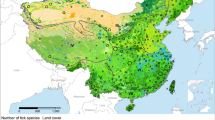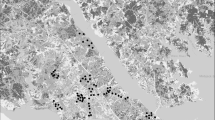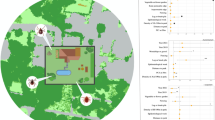Abstract
As humans and climate change alter the landscape, novel disease risk scenarios emerge. Understanding the complexities of pathogen emergence and subsequent spread as shaped by landscape heterogeneity is crucial to understanding disease emergence, pinpointing high-risk areas, and mitigating emerging disease threats in a dynamic environment. Tick-borne diseases present an important public health concern and incidence of many of these diseases are increasing in the United States. The complex epidemiology of tick-borne diseases includes strong ties with environmental factors that influence host availability, vector abundance, and pathogen transmission. Here, we used 16 years of case data from the Minnesota Department of Health to report spatial and temporal trends in Lyme disease (LD), human anaplasmosis, and babesiosis. We then used a spatial regression framework to evaluate the impact of landscape and climate factors on the spread of LD. Finally, we use the fitted model, and landscape and climate datasets projected under varying climate change scenarios, to predict future changes in tick-borne pathogen risk. Both forested habitat and temperature were important drivers of LD spread in Minnesota. Dramatic changes in future temperature regimes and forest communities predict rising risk of tick-borne disease.




Similar content being viewed by others
References
Allan BF, Keesing F, Ostfeld RS (2003) Effect of forest fragmentation on Lyme disease risk. Conservation Biology 17, 267-272.
Altizer S, Ostfeld RS, Johnson PT, Kutz S, Harvell CD (2013) Climate change and infectious diseases: from evidence to a predictive framework. Science 341, 514-519.
Bacon RM, Kugeler KJ, Mead PS (2008) Surveillance for Lyme disease–United States, 1992–2006. Department of Health & Human Services, Centers for Disease Control and Prevention
Bivand R, Altman M, Anselin L, et al. (2011) R Package ‘spdep’: spatial dependence: weighting schemes, statistics and models. http://cran.r-project.org/web/packages/spdep/index.html
Brinkerhoff RJ, Folsom-O’Keefe CM, Tsao K, Diuk-Wasser MA (2009) Do birds affect Lyme disease risk? Range expansion of the vector-borne pathogen Borrelia burgdorferi. Frontiers in Ecology and the Environment 9, 103-110.
Burnham KP, Anderson DR (2002) Model selection and multimodel inference: a practical information-theoretic approach. New York, NY: Springer
Council of State and Territorial Epidemiologists (1997) Case definitions for infectious conditions under public health surveillance. MMWR 46 (No. RR-10)
Demma LJ, Holman RC, McQuiston JH, Krebs JW, Swerdlow DL (2005) Epidemiology of human ehrlichiosis and anaplasmosis in the United States, 2001-2002. The American journal of tropical medicine and hygiene 73, 400-409.
Diuk-Wasser MA, Liu Y, Steeves T, et al. (2014) Monitoring human Babesiosis emergence through vector surveillance New England, USA. Emerging Infectious Diseases 20, 225-231.
Diuk-Wasser MA, Vourc’h G, Cislo P, et al. (2010) Field and climate-based model for predicting the density of host-seeking nymphal Ixodes scapularis, an important vector of tick-borne disease agents in the eastern United States. Global Ecology and Biogeography 19, 504-514.
Dobson AD, Randolph SE (2011) Modelling the effects of recent changes in climate, host density and acaricide treatments on population dynamics of Ixodes ricinus in the UK. Journal of Applied Ecology 48, 1029-1037.
Duffy DC, Campbell SR, Clark D, DiMotta C, Gurney S (1994) Ixodes scapularis (Acari: Ixodidae) deer tick mesoscale populations in natural areas: effects of deer, area, and location. Journal of medical entomology 31, 152-158.
Estrada-Pena A (2002) Increasing habitat suitability in the United States for the tick that transmits Lyme disease: a remote sensing approach. Environmental health perspectives 110, 635.
Gatewood AG, Liebman KA, Vourc’h Gl, et al. (2009) Climate and tick seasonality are predictors of Borrelia burgdorferi genotype distribution. Applied and Environmental Microbiology 75, 2476-2483
Githeko AK, Lindsay SW, Confalonieri UE, Patz JA (2000) Climate change and vector-borne diseases: a regional analysis. Bulletin of the World Health Organization 78, 1136-1147.
Guerra M, Walker E, Jones C, et al. (2002) Predicting the Risk of Lyme Disease: Habitat Suitability for Ixodes scapularis in the North Central United States. Emerging Infectious Diseases 8, 289-297.
Hamer SA, Tsao JI, Walker ED, Hickling GJ (2010) Invasion of the Lyme disease vector Ixodes scapularis: implications for Borrelia burgdorferi endemicity. EcoHealth 7, 47-63.
Harrus S, Baneth G (2005) Drivers for the emergence and re-emergence of vector-borne protozoal and bacterial diseases. International journal for parasitology 35, 1309-1318.
Harvell D, Altizer S, Cattadori IM, Harrington L, Weil E (2009) Climate change and wildlife diseases: when does the host matter the most? Ecology 90, 912-920.
Hayhoe K, VanDorn J, Croley II T, Schlegal N, Wuebbles D (2010) Regional climate change projections for Chicago and the US Great Lakes. Journal of Great Lakes Research 36, 7-21.
Hess G, Randolph S, Arneberg P, et al. (2002) Spatial aspects of disease dynamics. In: The ecology of wildlife diseases (ed. PJ Hudson AR, BT Grenfell, H Heesterbeek, AP Dobson), pp. 102-118. Oxford University Press, Oxford, UK
Iverson LR, A. M. Prasad, S. N. Matthews, Peters M (2008) Estimating potential habitat for 134 eastern US tree species under six climate scenarios. Forest Ecology and Management 254, 390-406.
Jones C, Kitron U (2000) Populations of Ixodes scapularis (Acari: Ixodidae) are modulated by drought at a Lyme disease focus in Illinois. Journal of medical entomology 37, 408-415.
Killilea ME, Swei A, Lane RS, Briggs CJ, Ostfeld RS (2008) Spatial dynamics of Lyme disease: a review. EcoHealth 5, 167-195.
Krause PJ, McKay K, Gadbaw J, et al. (2003) Increasing health burden of human babesiosis in endemic sites. The American journal of tropical medicine and hygiene 68, 431-436.
Kurtenbach K, Hanincova K, Tsao JI, et al. (2006) Fundamental processes in the evolutionary ecology of Lyme borreliosis. Nature Reviews Microbiology 4, 660-669.
Lawson AB (2013) Statistical Methods in Spatial Epidemiology. New York: Wiley
Leger E, Vourc’h G, Vial L, Chevillon C, McCoy KD (2013) Changing distributions of ticks: causes and consequences. Experimental and Applied Acarology 59, 219-244.
Levi T, Kilpatrick AM, Mangel M, Wilmers CC (2012) Deer, predators, and the emergence of Lyme disease. Proceedings of the National Academy of Sciences 109, 10942-10947.
Lewellen RH, Vessey SH (1998) The effect of density dependence and weather on population size of a polyvoltine species. Ecological Monographs 68, 571-594.
Lindgren E, Talleklint L, Polfeldt T (2000) Impact of climatic change on the northern latitude limit and population density of the disease-transmitting European tick Ixodes ricinus. Environmental health perspectives 108, 119.
Lindsay LR, Barker IK, Surgeoner GA, et al. (1998) Survival and development of the different life stages of Ixodes scapularis (Acari: Ixodidae) held within four habitats on Long Point, Ontario, Canada. Journal of medical entomology 35, 189-199.
Lindsay LR, Barker IK, Surgeoner GA, et al. (1995) Survival and development of Ixodes scapularis (Acari: Ixodidae) under various climatic conditions in Ontario, Canada. Journal of medical entomology 32, 143-152.
LoGiudice K, Ostfeld RS, Schmidt KA, Keesing F (2003) The ecology of infectious disease: effects of host diversity and community composition on Lyme disease risk. Proceedings of the National Academy of Sciences 100, 567-571.
Matthews JN (2005) Summary Measures Analysis of Longitudinal Data. Encyclopedia of Biostatistics. Wiley: New York
McCabe GJ, Bunnell JE (2004) Precipitation and the occurrence of Lyme disease in the northeastern United States. Vector-Borne and Zoonotic Diseases 4, 143-148.
Minnesota Department of Natural Resources. http://deli.dnr.state.mn.us/data_catalog.html. Accessed May 2013
MN State Climatology Office. http://climate.umn.edu/. Accessed May 2013
Nakicenovic N, Alcamo J, Davis G, et al. (2000) Special report on emissions scenarios: a special report of Working Group III of the Intergovernmental Panel on Climate Change. Pacific Northwest National Laboratory, Richland, WA (US), Environmental Molecular Sciences Laboratory (US).
Nupp TE, Swihart RK (1998) Effects of forest fragmentation on population attributes of white-footed mice and eastern chipmunks. Journal of Mammalogy, 79:1234-1243
Ogden N, Bigras-Poulin M, Hanincova K, et al. (2008) Projected effects of climate change on tick phenology and fitness of pathogens transmitted by the North American tick Ixodes scapularis. Journal of Theoretical Biology 254, 621-632.
Ogden N, Bigras-Poulin M, O’callaghan C, et al. (2005) A dynamic population model to investigate effects of climate on geographic range and seasonality of the tick Ixodes scapularis. International journal for parasitology 35, 375-389.
Ogden N, Lindsay L, Beauchamp G, et al. (2004) Investigation of relationships between temperature and developmental rates of tick Ixodes scapularis (Acari: Ixodidae) in the laboratory and field. Journal of medical entomology 41, 622-633.
Ogden N, Maarouf A, Barker I, et al. (2006) Climate change and the potential for range expansion of the Lyme disease vector Ixodes scapularis in Canada. International journal for parasitology 36, 63-70.
Ogden NH, Lindsay LR, Leighton PA (2013) Predicting the rate of invasion of the agent of Lyme disease Borrelia burgdorferi. Journal of Applied Ecology 50, 510-518.
Ostfeld R, Cepeda O, Hazler K, Miller M (1995) Ecology of Lyme disease: habitat associations of ticks (Ixodes scapularis) in a rural landscape. Ecological Applications 5, 353-361.
Ostfeld R, Keesing F, LoGiudice K (2006) Community ecology meets epidemiology: the case of Lyme disease. In: Disease ecology: community structure and pathogen dynamics (eds. Collinge S, Ray C), pp. 28–40. Oxford University Press, Oxford, UK.
Perret J-L, Guigoz E, Rais O, Gern L (2000) Influence of saturation deficit and temperature on Ixodes ricinus tick questing activity in a Lyme borreliosis-endemic area (Switzerland). Parasitology Research 86, 554-557.
Pfaffle M, Littwin N, Muders SV, Petney TN (2013) The ecology of tick-borne diseases. International Journal for Parasitology 43:1059–1077
Prasad AM, Iverson LR, Matthews S, Peters M (2007) A Climate Change Atlas for 134 Forest Tree Species of the Eastern United States [database]. Delaware, OH: Northern Research Station, USDA Forest Service. http://www.nrs.fs.fed.us/atlas/tree. Accessed May 2014
Pritt BS, Sloan LM, Johnson DKH, et al. (2011) Emergence of a new pathogenic Ehrlichia species, Wisconsin and Minnesota, 2009. New England Journal of Medicine 365, 422-429.
Pryor S, Barthelmie R, Schoof J (2013) High-resolution projections of climate-related risks for the Midwestern USA. Climate research 56, 61-79.
Randolph S (1998) Ticks are not insects: consequences of contrasting vector biology for transmission potential. Parasitology Today 14, 186-192.
Randolph SE (2010) To what extent has climate change contributed to the recent epidemiology of tick-borne diseases? Veterinary parasitology 167, 92-94.
Robinson C, Schumacker RE (2009) Interaction effects: centering, variance inflation factor, and interpretation issues. Multiple Linear Regression Viewpoints 35, 6-11.
Rogers D, Randolph S (2006) Climate change and vector-borne diseases. Advances in Parasitology 62, 345-381.
Schmid GP, Horsley R, Steere AC, et al. (1985) Surveillance of Lyme disease in the United States, 1982. Journal of Infectious Diseases 151, 1144-1149.
Schulze TL, Jordan RA (2003) Meteorologically mediated diurnal questing of Ixodes scapularis and Amblyomma americanum (Acari: Ixodidae) nymphs. Journal of medical entomology 40, 395-402.
Schulze TL, Jordan RA, Hung RW (2001) Effects of selected meteorological factors on diurnal questing of Ixodes scapularis and Amblyomma americanum (Acari: Ixodidae). Journal of medical entomology 38, 318-324.
Schwartz BS, Goldstein MD (1990) Lyme disease in outdoor workers: risk factors, preventive measures, and tick removal methods. American Journal of Epidemiology 131, 877-885.
Simon JA, Marrotte RR, Desrosiers N, et al. (2014) Climate change and habitat fragmentation drive the occurrence of Borrelia burgdorferi, the agent of Lyme disease, at the northeastern limit of its distribution. Evolutionary Applications 7:750–764
Steere AC, Malawista SE, Snydman DR, et al. (1977) An epidemic of oligoarticular arthritis in children and adults in three Connecticut communities. Arthritis & Rheumatism 20, 7-17.
Sumilo D, Bormane A, Asokliene L, et al. (2006) Tick-borne encephalitis in the Baltic States: identifying risk factors in space and time. International Journal of Medical Microbiology 296, 76-79.
U.S. Census Bureau (2010) Data generated using American FactFinder. http://factfinder2.census.gov/faces/nav/jsf/pages/index.xhtml. Accessed May 2013
Vail SG, Smith G (2002) Vertical movement and posture of blacklegged tick (Acari: Ixodidae) nymphs as a function of temperature and relative humidity in laboratory experiments. Journal of medical entomology 39, 842-846.
Wall MM (2004) A close look at the spatial structure implied by the CAR and SAR models. Journal of Statistical Planning and Inference 121, 311-324.
Waller LA, Gotway CA (2004) Applied spatial statistics for public health data. New York, NY: Wiley.
Wilson ML, Adler GH, Spielman A (1985) Correlation between abundance of deer and that of the deer tick, Ixodes dammini (Acari: Ixodidae). Annals of the Entomological Society of America 78, 172-176.
Woolhouse ME, Gowtage-Sequeria S (2005) Host range and emerging and reemerging pathogens. Emerging Infectious Diseases 11, 1842.
Acknowledgments
We thank the graduate student team at MDH for conducting TBP case follow-up. This work was supported by the University of Minnesota Institute on the Environment and Cooperative Agreements (U50/CCU510333-06). Partial support for UGM came from NIH Grant (R01AI042792).
Author information
Authors and Affiliations
Corresponding author
Rights and permissions
About this article
Cite this article
Robinson, S.J., Neitzel, D.F., Moen, R.A. et al. Disease Risk in a Dynamic Environment: The Spread of Tick-Borne Pathogens in Minnesota, USA. EcoHealth 12, 152–163 (2015). https://doi.org/10.1007/s10393-014-0979-y
Received:
Revised:
Accepted:
Published:
Issue Date:
DOI: https://doi.org/10.1007/s10393-014-0979-y




